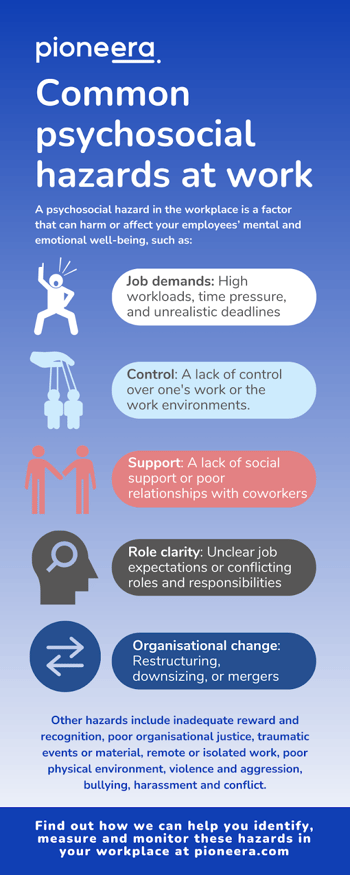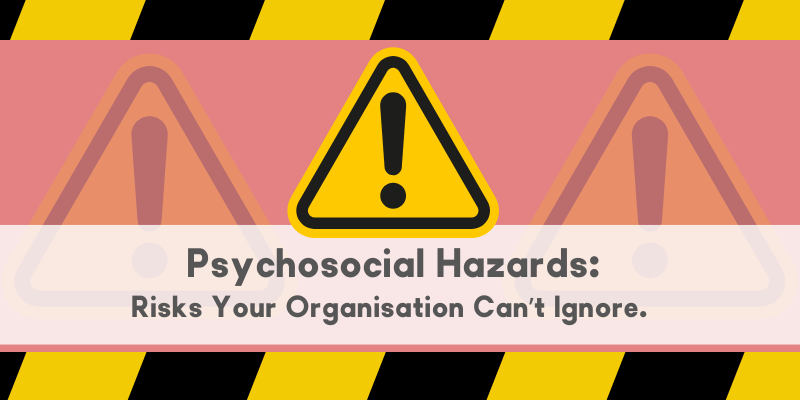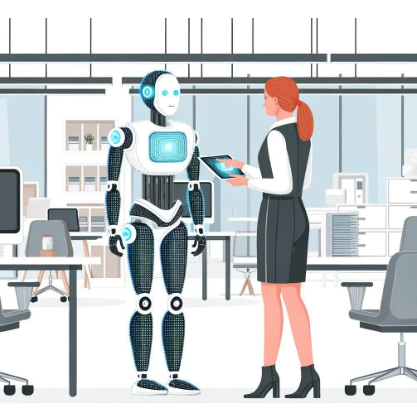As leaders, it's our responsibility to provide a safe and healthy work environment that minimises the risk of psychosocial hazards. Of course, you want to reduce potential harm to your employees to keep them safe, improve their well-being and job satisfaction, and enhance your organisation's overall productivity and success. But this isn’t always easy, especially with remote and hybrid working.
We’re here to help you prepare and take action on any psychosocial hazards that exist in your organisation for the sake of your people and your organisation:
What is a psychosocial hazard?
Psychosocial hazards are described as any factor that can cause psychological harm. A psychosocial hazard in the workplace is a factor that can harm or affect your employees’ mental and emotional well-being (e.g. harm someone’s mental health), such as stress, bullying, harassment, violence, and poor working conditions.
Psychosocial risks are estimated to cost Australian companies billions of dollars yearly regarding reduced productivity, absenteeism, and presenteeism. A PwC report indicated that mental health issues alone cost Australian workplaces $10.9 billion annually – $4.7 billion in absenteeism, $6.1 billion in presenteeism and $146 million in compensation claims.
Common psychosocial hazards at work can include:
- Job demands: High workloads, time pressure, and unrealistic deadlines can contribute to workplace stress.
- Control: A lack of control over one's work or the work environment can contribute to feelings of helplessness and stress.
- Support: A lack of social support or poor relationships with coworkers and supervisors can contribute to feelings of isolation and stress.
- Role clarity: Unclear job expectations or conflicting roles and responsibilities can contribute to stress and anxiety.
- Organisational change: Major changes such as restructuring, downsizing, or mergers can contribute to uncertainty and stress.

Other hazards identified are inadequate reward and recognition, poor organisational justice, traumatic events or material, remote or isolated work, poor physical environment, violence and aggression, bullying, harassment, including sexual harassment, and conflict or poor workplace relationships and interactions.
How can psychosocial hazards harm your employees?
These hazards can potentially induce stress in workers when they perceive that their work demands exceed their ability or resources to cope. When stress is present, it triggers a physiological and psychological response in the body by releasing adrenaline and cortisol, raising the heart rate and blood pressure, boosting glucose levels in the bloodstream, and diverting energy from the immune system to other parts of the body.
Although stress is not an injury, frequent, prolonged, or severe stress can cause psychological and physical harm to your employees. This harm can lead to decreased job satisfaction, poor performance, absenteeism, high turnover rates, and long-term health issues.
Guidelines to help workplaces manage mental health risks under a global standard of practice have been introduced by the International Organization for Standardisation (ISO 45003).
The World Health Organization (WHO) recently estimated that depression and anxiety disorders cost the global economy approximately $1 trillion annually in terms of lost productivity, underscoring the substantial financial impact of these risks.
It's crucial to give mental health the attention it deserves in the workplace. When you implement a plan to manage psychological health and safety, you create a positive work environment where people feel good and do their best work. Taking mental health and wellbeing into account makes your organisation stronger and more resilient, improves productivity, and makes everything run smoother.
ISO 45003, introduced in March 2023, offers practical guidance for managing psychological health in the workplace. The standard provides instructions on managing psychosocial risk as part of an occupational health and safety management system.
The standard encompasses:
- Identifying psychosocial hazards that can impact workers, including those associated with remote working.
- Examples of simple and effective measures workplaces can implement to manage these risks and enhance employee well-being.
ISO 45003 provides a framework for organisations to identify, assess, and manage psychosocial risks in the workplace. It emphasises the importance of a proactive approach to prevent psychosocial hazards and promote mental health and well-being in the workplace.
The ISO 45003 framework sits alongside the recently published WHO guidelines on mental health at work. These guidelines provide evidence-based recommendations to promote mental health, prevent mental health conditions, and enable people living with mental health conditions to participate and thrive in work. These two initiatives demonstrate that this is a globally recognised problem with a high financial and human cost.
Understanding Psychosocial Hazards in the workplace is not just a “nice to have”.
Many countries now have regulations or guidelines that require employers to manage psychosocial risks and protect employees' mental health as law. Examples include the Framework Directive 89/391/EEC in the European Union and specific legislation in Australia (Workplace Health and Safety Regulations) and Canada (Canada Labour Code).
There are considerable legal, financial and human capital costs to ignoring Psychosocial Hazards in the workplace; what action will you and your team take to protect your people and your business?
Pioneera is the only company in the world that can provide organisations with real-time data on mental health and wellbeing levels in their workplace. Request a no-obligation chat with one of our team to see if we can help you identify, measure and monitor psychosocial hazards in your workplace.







